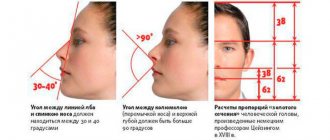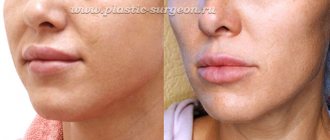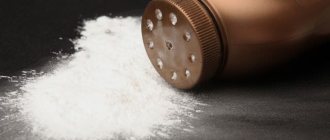Stretch marks heal on their own
Like any other scar, stretch marks on the abdomen do not disappear on their own. The processes that lead to the appearance of grooves on the skin occur in the middle layer of the skin - the dermis. Damage to the elastic fibers of the dermis is accompanied by inflammation, which leads to scarring.
During periods of rapid growth, weight gain or pregnancy, the skin is forced to quickly adapt to a sharp change in body size. Depending on age, genetics, and the general condition of the body, the dermis may not be able to stretch quickly enough. Thin weak areas and breaks appear in it. These weakened areas are usually red, violet, or purple in color. Over time, the tears are healed by connective tissue and actually decrease in size, but they will never completely disappear.
Removal methods
Every person wants to get rid of the “ugly mark” on the stomach, be it a young girl, an adult woman in the postpartum period, or a man after surgery for appendicitis.
There are many ways to remove scars completely or reduce their size to barely noticeable ones.
We recommend reading:
Prevention of complications of cesarean scar healing
Ointments and creams
The use of ointments and creams must begin in the early stages of formation. This will help avoid the growth of scar tissue and promote rapid regeneration of the skin. Effective drugs in this group are:
- Conractubex. The drug contains components that help slow down the growth of connective tissues. The product has an anti-inflammatory and softening effect. Apply twice a day, applied to a healed wound surface.
- Dermatix. Gel for treating scars. Smoothes the surface, relieves itching, promotes rapid resorption of protruding tissues. Gives the skin a well-groomed and healthy look.
- Clearvin is used as a remedy to eliminate caesarean section scars and skin stretch marks in girls during the postpartum period. A drug based on plant components lightens the surface of the scar and improves blood supply to the affected area.
Before using any drug, in order to avoid negative consequences, you should consult your doctor.
Hardware techniques
To remove abdominal scars, beauty salons use several techniques.
Cryotherapy – removal of scars with liquid nitrogen. Under the influence of low temperature, the formation tissues are destroyed and die. An invisible thin strip remains on the surface of the skin.
Laser skin resurfacing (laser peeling) is the most popular method of eliminating tumors. The procedure is carried out with a special device with a laser beam, which burns out the upper layers of scar tissue. To completely restore the skin, you will need 5–6 sessions.
Mesotherapy is a procedure when special drugs are injected into the scar tissue by injection to help dissolve the growth.
Surgical intervention
Surgery is the most invasive method of scar removal and is performed in extreme cases (for keloid scars). The plastic surgeon cuts off excess tissue with a scalpel. The result of the procedure is an unnoticeable cosmetic thin scar.
Stretch marks don't change color
Striae appear as long, narrow stripes on the body, initially red or pink in color with purple streaks. The coloring is due to the fact that injured vessels appear through tears in the dermis. At this stage, dermatologists call stretch marks striae - rubra. Damaged nerve endings in the dermis are restored, so sometimes stretch marks itch and itch.
As the tissues scar, the stripes fade and acquire a silvery tint, becoming a striae alba.
Fresh, vibrant stretch marks respond better to treatment than established ones. The essence of most methods is to improve blood circulation in the skin. Exfoliation, exercise, massage, and you can look for a swimsuit for the beach season!
What to do at home?
Let's look at how to care for an appendicitis scar after surgery:
- For the first two to three weeks, it is very important to follow a strict diet, eating only liquid and porridge-like foods. It is very important to completely exclude baked goods, cabbage and legumes from your diet, as these foods cause severe gas formation. Abdominal bloating can lead to rupture of not only internal but also external scars, which will cause inflammation.
- If, after you switched from hospital food to homemade food, you begin to experience constipation, doctors recommend taking laxatives. However, it is best if they are in the form of suppositories for rectal use. In no case should you push, straining your abdominal muscles, as this can also lead to rupture of the scar.
- In the first week after the operation, do not lift anything heavier than five kilograms, and in the next month - nothing heavier than ten kilograms.
- It is also very important to take care of the scar itself. After showering, be sure to use an antiseptic as recommended by your doctor. Never take a warm bath for six to ten days after leaving the hospital. After applying the antiseptic, wait until it dries. And only apply a bandage to the dry scar and get dressed.
- Under no circumstances should you perform physical exercises that will strain your abdominal muscles. This also includes running. However, if physical activity is unavoidable, be sure to use a support bandage.
Stretch marks appear only due to excess weight
Skin stretching is the most common and obvious cause of stretch marks, but not the only one. The production of collagen and elastin in the dermis is influenced by hormonal factors. An increase in cortisol levels in the body leads to catabolism (destruction) of tissue in any part of the body, including ligaments, muscles and blood vessels. Cortisol breaks down collagen, reducing skin elasticity.
Anabolic steroids, which men take to build muscle mass, change hormonal levels and can also push the process of stretch marks to appear. Stripes on the arms and stomach of an athlete are a sign of steroid abuse.
Surgical excision
Excellent for old, already healed seams - no other methods will help in this case. The procedure is performed under general anesthesia and has many contraindications – from heart and vascular diseases to inflammatory processes in the body.
During the operation, the scar tissue is excised with a surgical instrument, the edges of the skin are again compared and sutured with a cosmetic suture. The postoperative period involves going through all stages:
- daily dressings until primary wound healing;
- the use of anti-scar creams and ointments;
- conducting a course of chemical peeling.
Most often, surgical excision of a scar is used if its edges are uneven, the scar itself is too wide and convex or retracted in relation to the surrounding skin.
Stretch marks disappear after weight loss
Losing weight has many health benefits, but it won't get rid of stretch marks; most of the damage to your skin occurs when you gain weight. A stretch mark on the abdomen is a scar in the dermis that will remain for life. Gradually, the stripes fade, acquire a whitish or pearlescent tint and become less noticeable. But they never completely disappear.
Advice! Rapid weight loss affects the body's hormonal balance and can lead to the formation of new stretch marks. Safe weight loss – 400-800 g per week.
This does not mean that you can give up on extra pounds. Staying overweight for a long time aggravates the situation. The skin suffers from pressure, new marks appear on the body. Exercise, massage and a healthy diet will improve your body contours; An arsenal of cosmetic products will thicken the epidermis and smooth out unsightly grooves. Tight jeans, fashionable swimsuits - why not? Whitish stripes do not attract the eye on a toned, harmonious body.
Tattoos on scars from cesarean section, appendicitis: what scars can be tattooed on?
Skin injuries, visible defects and irregularities very often create psychological discomfort, against the background of which girls and men develop complexes. In order to get a tattoo on a scar, you must follow the main rule - the scar must be in the final stages of healing. That is, tattoos cannot be applied to fresh scars; the period from their appearance to tattooing should be about one year.
Type of scars and the possibility of creating tattoos on their surface:- Atrophic - outwardly it is a whitish area of skin that is slightly deeper than the general level of the skin. These scars can result from minor burns, cuts, or acne. Atrophic scars also include stretch marks after weight loss or childbirth. Tattooing on atrophic scars is permitted and easily hides the visible defect.
- Normotrophic - appear as a result of small wounds, are located at a general level, do not have swelling and are whitish in color. Tattoos on such scars are easy to make, skin defects are completely hidden.
- Hypertrophic - scars that form after major surgery. Outwardly, these are dark scars with a convex texture; they can be hidden, but this is difficult and expensive.
- Keloids - appear on the body a couple of months after operations, can grow, applying tattoos to this type of scars is prohibited.
- Papillomas or birthmarks. As you know, blood capillaries are hidden under these irregularities, so tattooing on them is strictly prohibited. Any intervention in this area can provoke the growth of cancer cells, so the only acceptable solution is a tattoo that bypasses these areas or includes them as part of the picture.
Striae occur only on the stomach
Stretch marks on the abdomen after pregnancy occur in most women, a sad fact. But this is not the only area that the telltale stripes can affect. The skin of the chest, buttocks and thighs is also subject to atrophic changes. Choosing a swimsuit becomes difficult; a bikini does not hide stretch marks on the stomach. There is no need to wrap your figure in a pareo - swimsuits with a jumper on the stomach leave the back open, hiding imperfections from prying eyes.
Advice! Graceful monokini swimsuits emphasize the figure, hiding the stomach in stretch marks.
Weightlifters and bodybuilders have especially vulnerable skin on the upper body. Men focus on the muscles of the chest and shoulder girdle, seeking to increase volume in a short time. Why did stretch marks appear on the shoulders? Muscle growth has exceeded the skin's ability to stretch. A strict exercise schedule, moisturizers and massage prevent damage to the dermal layer.
How to care for a fresh scar?
Typically, a week after surgery, the patient is discharged from the hospital. However, if the operation was accompanied by complications, this period may be extended. Of course, while the person is in the hospital, a nurse will carefully care for the scar. She will carry out antiseptic procedures, as well as bandage and monitor the condition of the scar. But as soon as a person goes home, he will have to take care of himself, strictly following all the recommendations that he will be given in a medical institution.
Stretch marks cannot be prevented
Once a striae has gone through all stages of development, it is difficult to make it disappear. Prevention is the best solution. A long stretch on the stomach is not a death sentence.
You can minimize the likelihood of streaking by:
- Hydration. Drink a lot of water, use creams and oils - dehydrated skin is less elastic.
- Proper nutrition. Focus on collagen-rich foods: lean meats, green vegetables and fruits, bone broth.
- Weight control.
If, despite the measures taken, a stretch mark appears on the abdomen, itches and has acquired color, it is necessary to stop its development while it is red. According to doctors, products with retinoids and glycolic acid have proven themselves well.
Important! Retinol creams are contraindicated in pregnant women.
Tattoo on scars: features
Features of tattoos that hide skin defects:
- The wound must heal completely, otherwise complications may occur when applying a tattoo, and the design may “slip.”
- When choosing a color scheme, you should give preference to bright tattoos containing 4-5 colors in the sketch; monotonous tattoos are not advisable.
- You can mask unevenness using shadows, highlights and midtones.
- The scar has a broken skin structure, so it is able to absorb a layer of paint.
- In order to check whether a tattoo is suitable, you can get a temporary tattoo, the service life of which is about 3 weeks.
There is no need to treat stretch marks
Striae cause physical discomfort to a person - they itch during the healing process of the tears. If the symptom is left unattended, constant trauma to the skin with nails leads to inflammation. The use of external products soothes damaged skin and facilitates the restoration of connective tissue.
Methods for treating stretch marks are aimed at mitigating external manifestations:
- LPG massage;
- laser therapy;
- chemical peels;
- microdermoforms;
- abdominoplasty (in case of an overhanging “apron”).
Appearance is important for both men and women; there is no gender discrimination here. The presence of stripes reduces self-esteem, drives a person into emotional stress, and forces one to hide defects with one-piece swimsuits and long-sleeve T-shirts. It is possible and necessary to get rid of psychological stress with the help of cosmetology.
Grinding
This refers to chemical peeling, which is carried out using products based on organic acids.
This procedure should be carried out in a beauty salon or specialized clinic, because it is important to strictly follow the algorithm for its implementation.
Chemical peeling does not always guarantee the removal of a scar, but it will make the scar less noticeable, pale, and almost smooth.
It is important to understand that chemical peeling is an aggressive effect on the skin, so it is contraindicated in the first 6 to 10 months after a cesarean section, with a history of cancer, pelvic varicose veins, and a high risk of uterine bleeding.
You can carry out the polishing procedure at home using professional cosmetics. They contain only fruit acids, which are gentle on the dermis. This treatment will make the scar less noticeable, but will not remove it.
The safest antiseptics
An appendicitis scar on your abdomen will heal much faster if your doctor can give you the right antiseptic medications. Using harsh drugs such as iodine can only make the situation worse, leading to chemical burns. In this case, the likelihood of developing a large, unsightly scar increases significantly. Let's consider what antiseptics are best to use in order not to harm damaged skin and speed up healing:
- hydrogen peroxide;
- fucorcin solution;
- brilliant green.
It is also recommended to treat a fresh scar with Hexicon or Amident. And for speedy healing, you can use medications such as Okomistin and Solcoseryl.
Please note that the scar will not smooth out and fade immediately, so you should not worry about the presence of a defect immediately after surgery.
Suture after abdominoplasty
The larger and larger the plastic surgery, the more undesirable consequences and side effects it has. In the case of a tummy tuck, a separate problem is the long surgical incisions, after which the skin will never be completely smooth.
The suture after abdominoplasty heals under conditions of strong tissue tension - because of this, in the first months the scar looks extremely unsightly, takes a long time to mature, and even after a long time it can break apart or become inflamed. Is it true that the scar will remain for life and will have to be hidden from prying eyes? What to do if outwardly he turns out to be completely inappropriate? Is it possible to speed up and facilitate the healing process? TecRussia.ru tells the details for those who are ready to make the necessary sacrifices for their beauty:
↑ What marks will remain on the stomach after abdominoplasty?
The total volume and technique of the operation depend mainly on the amount of excess skin and fatty tissue, as well as the presence of concomitant surgical diseases of the anterior abdominal wall in the patient (muscle separation, inguinal or umbilical hernia, etc.) The more tissue the surgeon needs to remove, the more the longer the incisions will be, and the more difficult it will be for the patient during the rehabilitation period.
| Type of abdominoplasty | Where and what will the seam be? |
| Classic abdominoplasty | The skin is incised horizontally across the entire abdomen - at the level of the pubis and protruding pelvic bones. If there is significant sagging, you will need an additional incision around the navel to move it to a new place - it may look like a circle, an inverted Y or U (the latter option is the least noticeable). |
| Vertical | This technique is used when the patient has diastasis of the rectus abdominis muscles, as well as significant excess skin after severe weight loss. For best results in this case, two incisions will be needed. One is horizontal, just like with classic abdominoplasty. The second is vertical, along the midline of the abdomen to the sternum. |
| Lateral | Here, too, there will be a main horizontal seam along the lower abdomen, but in addition to it there will be two additional ones, they are located on the sides. This technique allows you to remove excess fatty tissue around the entire circumference of the body (except for the back), as well as from the “buns” area on the lower back and tighten the outer surface of the thighs, due to which the waist becomes more pronounced and clear. |
| Extended | In this version of the operation, the entire hip area is additionally tightened. The basic incision extends from the abdomen to the sides and may extend well beyond the prominent portions of the ilia. |
| Circular | The most difficult option for a tummy tuck for both the plastic surgeon and the patient. It involves the removal of excess skin and fat not only from the anterior and lateral abdominal wall, but also from the outer surface of the thighs, and from the back in the lumbar region. The scar remains circular, running along the abdomen, sides and back of the torso. |
| Mini abdominoplasty | The incision is made in the suprapubic region (along the bikini line), horizontally. It will be somewhat shorter than with a classic operation: usually its length does not exceed 20 cm, and this is enough to remove a small excess of tissue and perform liposuction of the abdomen, sides and upper third of the thighs. |
Approximately 1 year after abdominoplasty, a correct, healed suture without complications looks like a fairly thin light-colored thread. It won't be very noticeable, but it won't be completely invisible either.
↑ Features of scarring after abdominoplasty
Surgical incisions in the lower abdomen heal in the same way as any other soft tissue injuries (for more details, see the article “Stages of scar formation”). But there are several factors that inevitably complicate this process:
- Drainage tubes may remain in postoperative wounds for several days;
- flaps of skin and subcutaneous tissue are under great tension (in many “before and after” photos of abdominoplasty you can see that the final scar in the middle looks wider than on the sides - the reason is precisely that closer to the center it stretches with the greatest force);
- in the immediate vicinity of the injured area there are abdominal muscles, even small contractions of which can lead to suture divergence;
- due to the overall complexity of the operation, the likelihood of suppuration, tissue necrosis and the development of other complications increases.
| Photo of the seam after abdominoplasty |
The greatest problems are usually caused by tissue tension, which will be especially strong in the first 1-2 months. For abdominoplasty, this condition is the norm, since a flat tummy is obtained only by excision of excess skin and fat in a sufficiently large amount. As a result, the postoperative scar is formed under very unfavorable conditions:
- At the stage of epithelization there is a high risk of divergence of the wound edges. In addition, stretched skin and soft tissues, and sometimes suture material, put pressure on the vessels, which creates the risk of developing necrosis (death) of large areas, and also slows down the process of formation of connective tissue and fusion of skin flaps.
- At the stage of a “young” scar (it begins approximately 2 weeks after tummy tuck), blood flow is more or less restored, but a new problem appears: constant tension on the skin flaps leads to excessive formation of fibroblasts and connective tissue fibers, due to which the scar often grows wide, convex and hard to the touch. Here, physiotherapeutic procedures or the use of special ointments/gels are almost always necessary, otherwise gross scarring will easily reduce the overall aesthetic result of the operation to zero.
To reduce the likelihood of suture dehiscence and facilitate its healing, for at least a month after surgery you will need to:
- walk slightly bent over and sleep with your legs crossed;
- avoid any physical activity, especially those that require contraction of the abdominal muscles;
- do not lift anything even remotely heavy;
- exclude any foods that can cause bloating and flatulence;
- give up any sports activities.
You will need to return to physical activity and usual sleeping positions very carefully and only after the approval of your surgeon.
↑ How to care for a seam so that it becomes as invisible as possible
Normally, changes in the appearance of the scar after tummy tuck will occur as follows:
| Time after plastic surgery | What's happening |
| 1 month | By this time, the wound should be completely healed. Due to increased blood flow and active collagen production, the scar will appear swollen, ranging in color from bright red to dark burgundy. It is worth preparing for the fact that in the next few months its appearance will not improve at all, moreover, there may be a tendency to worsen. |
| 6 months | The color remains red and the shape remains convex, but by this point positive changes should begin. Part of the fibrous tissue is destroyed, blood flow is reduced, due to this the seam should gradually begin to lighten and become flatter. |
| 1 year | By this point, the scar is considered mature, it becomes much paler and thinner than in the first months, and is no longer so striking. Over the next few years, its color and texture will continue to improve, although not as intensely. |
| 5 years or more | The shape and size are finally stabilized, but the scar’s tone may become a little lighter, due to which it will blend even more with the surrounding skin. |
The final appearance will depend on many factors: skin tone and texture, the patient’s genetic characteristics, the tendency to form keloids and connective tissue hypertrophy, as well as individual regeneration speed (some scars remain bright red for up to 1.5-2 years, and only then gradually fade). But the most important thing is how correctly and carefully the patient monitors him in the process of maturation:
↑ 1. The first days after surgery
The edges of the wound are secured with suture material and protected with a bandage. Even just touching them is extremely undesirable, not to mention any specific care. However, there are already enough problems: the stomach hurts and pulls, ichor and a small amount of blood can be released from the wound, brownish liquid constantly flows through the drainage tube, swelling and hematomas increase - the latter can spread far beyond the abdominal area, incl. go down to your hips. You just have to endure all this: normally, after a few days, the discomfort and symptoms gradually decrease. Painkillers will help, and you will most likely have to take a course of antibiotics to prevent purulent complications.
↑ 2. First 2 weeks
During this period, the postoperative wound is monitored by a doctor or nurse during planned dressing changes (usually they are done daily, in a day hospital setting). To prevent the formation of a rough scar, the following are carried out:
- treatment with antiseptics and regular dressing changes to prevent purulent complications;
- observation of the incision area for timely detection of foci of possible necrosis, as well as areas where tissues are strongly tied with threads or tucked inward;
- drainage - so that the constantly increasing volume of tissue exudate does not lead to divergence of the edges of the wound;
- measures to reduce swelling - compression garments, limiting fluid intake, etc.
Bed rest for 10-14 days after abdominoplasty is the best choice for those who want the incisions to heal without any “surprises.” The more a person rests, the lower the likelihood of overstretching, wound dehiscence and other problems that complicate scarring. Of the hygienic procedures, only a shower is allowed, but any thermal effects on the area of the postoperative wound should be avoided.
After two weeks, the state of the body and subjective well-being will noticeably improve. The only thing that will still bother the patient is a feeling of tightness in the sutured muscles of the anterior abdominal wall.
↑ 3. Young scar stage (first month after surgery)
Sutures placed after a tummy tuck are removed within 10-14 days. In the absence of complications, by this time the surface of the wound will be covered with epithelium (the first, not yet very strong connecting layer) - which means you can begin to use patches or ointments to promote the proper formation of the scar. When choosing the appropriate remedies, it is better to listen to your doctor. Most often, experts recommend:
- special silicone patches and gels that can be used individually or in combination;
- hormonal ointments;
- products based on heparin and other absorbable components.
Among the physiotherapeutic procedures, pressotherapy is indicated - it does not in any way threaten the fragile surface of the scar, while it allows you to activate blood circulation and lymph outflow, which has a beneficial effect on the condition of injured tissues.
| Important: the time to start using anti-rust agents is determined not by the number of days that have passed after the operation, but by the condition of the suture. Severe swelling, hematomas, the presence of unhealed areas, suppuration - all these are direct contraindications to their use. Until such complications are completely eliminated, you should only carry out regular dressings and strictly follow the instructions of your doctor. |
↑ 4. Caring for the scar at the stage of its maturation
This period lasts about 1 year, during which you can and should continue to take care of your stitch. The use of silicone patches and various ointments is not limited in time and does not cause harm to health, so many patients prefer to use them throughout the entire period of rehabilitation after abdominoplasty. With your doctor's permission, you can begin performing simple physical exercises, gradually increasing the intensity. But you will have to protect your stomach from ultraviolet rays: no one forbids sunbathing and spending time in the sun, but the operated area will need to be carefully covered to avoid hyperpigmentation. Physiotherapeutic procedures include dermotony, ozone therapy, and magnetic therapy.
- Electrophoresis with lidase: does it help in the treatment of scars?
- What complications can occur after abdominoplasty?
It is advisable to arrange regular check-ups with your surgeon or other specialist to monitor the healing process and ensure that it is proceeding without complications. Preliminary conclusions are usually made 6 months after abdominoplasty: if at this point the scar still remains rough and protruding, with no tendency to improve, the doctor may decide to inject corticosteroid hormones or drugs based on hyaluronidase (in no case should you do them yourself is not possible, since there is a risk of sunken areas and other negative consequences appearing at the injection sites).
↑ What to do if the edges of the wound are separated
Plastic surgeons know how much the tissues on the abdomen are stretched during a lift, so for their part they take all the necessary measures to keep them in a given position:
- use special threads and special suturing techniques;
- carry out thorough hemostasis and antiseptic treatment of the wound;
- give the patient clear recommendations regarding the rules of behavior for the first postoperative days (avoid physical activity, walk slightly hunched over, sleep with legs tucked, etc.)
However, no one is immune from seams coming apart. This should be remembered, monitor the condition of the wound and seek help in time if something goes wrong. The problem may be caused by the following factors:
- Excessively active work of the muscles of the anterior abdominal wall.
- Surgeon mistakes when choosing threads and/or suture methods.
- Suppuration is accompanied by redness of the skin, an increase in its temperature, and the appearance of copious exudate. As a result, the edges of the wound open up, and it will not be possible to stitch them back right away. First, you will have to treat and treat the wound to neutralize the inflammatory process. Only after this will it be possible to tighten the tissue again and apply sutures.
- Necrosis (death) of areas of skin pinched by threads so much that blood circulation in them is disrupted. Accompanied by pain, subsequent numbness and blackening of the affected areas. The necrosis zone can only cover the wound edges, but sometimes it has a much larger volume and requires transplantation of viable tissue from the lateral surfaces of the body to the place of dead tissue.
Whatever the reason, you should refrain from doing anything on your own and consult a doctor as soon as possible, in this case:
- continue to treat the wound according to the instructions you received from your plastic surgeon;
- avoid contracting the abdominal muscles;
- we use plasters to relieve the load from areas located on both sides of the split seam;
- We wear compression garments without fail, even if it seems that they have no effect;
- Avoid getting water and dirt into the scar area.
Depending on the clinical picture and the cause of the opening of the abdominal wound, the doctor will prescribe the necessary therapy and give recommendations for home care. The most problematic cases are inflammation and necrosis; their treatment can be long and quite expensive.
↑ Is it possible to improve the appearance of a formed seam?
In about 12 months, the scar on the abdomen finally matures and subsequently remains virtually unchanged, even with regular use of ointments and other external agents. If the patient is still not satisfied with its aesthetic characteristics, additional measures can be planned:
- Surgical excision of excess scar tissue. Unlike large plastic surgeries, it is performed under local anesthesia and does not involve complex rehabilitation. However, the mark that will remain after such manipulation will also be quite large, so it is advisable to carry it out only to correct the roughest and thickest scars.
- If the main problem is too bright, saturated color, then a fractional laser will give the best result. It seals the capillaries adjacent to the surface, the blood flow through them stops and the scar noticeably turns pale.
- When it is necessary to slightly improve and “tune” a normal, neat seam, abrasive salon procedures such as laser resurfacing or chemical peeling are used.
- For complete camouflage, you can apply a colored tattoo to the operated area.
It is worth remembering that if positioned correctly, the main horizontal scar will always be hidden under clothing: a swimsuit and underwear will reliably cover it. To be completely sure, some surgeons even suggest that their patients bring a swimsuit of their own style to the consultation in order to take all measurements on site and make sure that the fabric will be above the planned incision line. And those who are still worried about the appearance of their abdomen may be consoled by statistics: the vast majority of patients after abdominoplasty are confident that its aesthetic result is worth the marks that will remain on the body as a memory of the operation.
How can you remove an old scar?
It is not easy to remove a girl’s appendicitis scar, but it is still possible if you put effort and effort into it.
So, there are several methods to do this, namely:
- Surgical removal of a scar using a cosmetic suture. You can also inject a certain amount of fatty tissue into the connective tissue, which is taken from other parts of the patient’s body. This will help give the skin a normal structure. Thanks to this procedure, it is possible to completely even out the relief of the epidermis.
- A good result can be achieved using electrophoresis with drugs that dissolve fibrin. During healing, you can also use ultrasound, which accelerates metabolic processes in damaged tissue.
- Laser resurfacing is considered the most effective and fastest method. People resort to her help within six months after surgery.
- With the help of dermabrasion, you can give a smooth texture to the skin.
As you can see, there are many methods to remove appendicitis scars. Your doctor will tell you which method is right for you.











